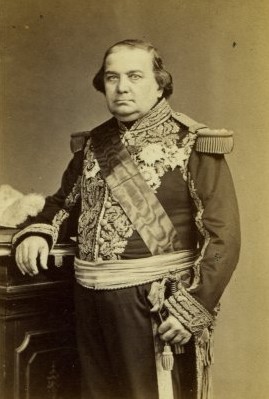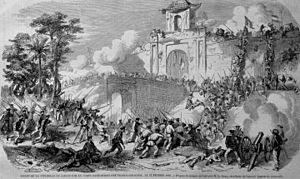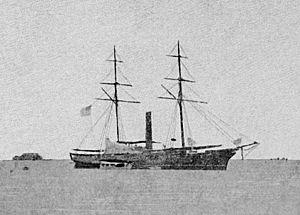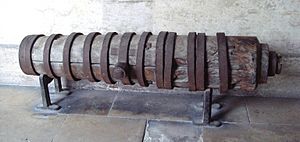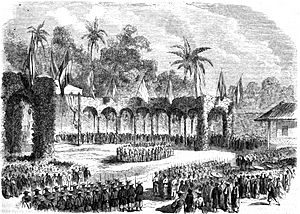Cochinchina campaign facts for kids
Quick facts for kids Cochinchina campaign |
|||||||||
|---|---|---|---|---|---|---|---|---|---|
| Part of the French conquest of Vietnam and Western imperialism in Asia | |||||||||
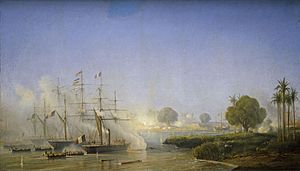 Capture of Saigon, Antoine Léon Morel-Fatio. |
|||||||||
|
|||||||||
| Belligerents | |||||||||
|
|
|||||||||
| Commanders and leaders | |||||||||
| Strength | |||||||||
| ~3,000 1 frigate 2 corvettes 2 avisos 9 gunboats |
10,000+ | ||||||||
| Casualties and losses | |||||||||
| 1,000 killed and wounded | Heavy | ||||||||
The Cochinchina campaign was a series of military actions between 1858 and 1862. It involved a combined naval force from France and Spain fighting against the Vietnamese state. This conflict marked the beginning of France's takeover of Vietnam.
The war started as a way to punish Vietnam for executing French and Spanish Catholic missionaries. However, the French emperor, Napoleon III, sent more and more troops. This led to France taking control of Vietnamese land and becoming very powerful in the region. The war ended with France creating the colony of Cochinchina. This began almost a century of French colonial rule in Vietnam and the surrounding areas.
Contents
Why the War Started: Background Events
In the mid-1800s, European countries were rapidly expanding their empires. France wanted to gain more influence in Asia, Africa, and Latin America. Vietnam was an independent country that became a main target for France's plans to expand its power.
Some French leaders believed that the Vietnamese emperor, Gia Long, owed France a favor. This was because France had helped him fight his enemies earlier. However, Gia Long felt he didn't owe France anything. He said that the French government didn't keep its promise to help him in the civil war. Instead, only volunteers helped him. Still, Gia Long and his successor, Minh Mạng, wanted to continue working with France. This allowed them to get French military help and buy weapons like cannons and rifles.
French missionaries had been in Vietnam since the 1600s. By the mid-1800s, about 600,000 Vietnamese people had become Catholic. However, most of the Catholic leaders were French or Spanish. Many Vietnamese people did not trust this large Christian group and its foreign leaders. French priests felt responsible for the safety of the Catholic community as tensions grew.
In 1857, the Vietnamese emperor, Tự Đức, ordered the execution of two Spanish Catholic missionaries. This was not the first time such an event happened. In the past, France had mostly ignored these actions. But this time, France was already sending troops to China for the Second Opium War. France decided to use these forces to also get involved in Vietnam. In November 1857, Napoleon III ordered Admiral Charles Rigault de Genouilly to lead a mission to punish Vietnam. In September 1858, a combined French and Spanish force landed at Tourane (now Da Nang) and captured the city.
Battles at Tourane and Saigon
Fighting at Tourane
The French and Spanish forces expected an easy victory, but the war did not go as planned. The Vietnamese Christian community did not support France as much as expected. Also, the Vietnamese military put up a stronger fight than anticipated. The French and Spanish captured Tourane but could not move further inland. They were stuck in a long siege by a Vietnamese army led by Nguyễn Tri Phương. Even with reinforcements, the allied forces could not break the siege. The Siege of Tourane lasted for almost three years. Although there wasn't much direct fighting, many French and Spanish soldiers died from diseases.
In October 1858, Admiral Charles Rigault de Genouilly realized that the French forces at Tourane were not making progress. He considered attacking either Tonkin or Cochinchina. Since an attack on Tonkin would need a large uprising by Vietnamese Christians (which was unlikely), he suggested attacking Saigon in Cochinchina in January 1859. Saigon was important because it supplied food for the Vietnamese army.
The Attack on Saigon
The plan to attack Saigon was approved. In early February, Rigault de Genouilly sailed south to Saigon. He left a small French force at Tourane. On February 17, 1859, the French and Spanish captured Saigon. They first broke through river defenses and destroyed forts along the Saigon river. French soldiers stormed the huge Citadel of Saigon. Filipino troops, fighting with the Spanish, stopped a Vietnamese counterattack.
However, the allies did not have enough soldiers to hold the citadel. So, on March 8, 1859, they destroyed it and burned the rice storage buildings. In April, Rigault de Genouilly returned to Tourane with most of his forces. He left about 1,000 French and Spanish soldiers in Saigon.
The small allied force in Saigon struggled to keep control. They suffered heavy losses in a surprise attack on a Vietnamese fort west of Saigon on April 21, 1859. After this, they had to stay within their defenses. Meanwhile, the Austro-Sardinian War in Europe meant France had fewer troops available. In November 1859, Admiral François Page replaced Rigault de Genouilly. Page was told to make a treaty that protected Catholics in Vietnam, not to gain land. In early November, Page started talks, but they did not go well.
The Vietnamese knew France was busy with the war in Italy. They refused the moderate peace terms and dragged out the talks. They hoped the allies would give up and leave. On November 18, 1859, Page attacked and captured the Kien Chan forts at Tourane. But this victory did not change the Vietnamese leaders' minds. The war continued into 1860.
The Siege of Saigon
During late 1859 and all of 1860, the French could not make big advances or gain more land at Tourane and Saigon. Although the war in Italy ended in early 1860, France was now fighting China again. Admiral Page had to send most of his forces to help Admiral Léonard Charner in China. In April 1860, Page left Cochinchina to join Charner.
Meanwhile, in March 1860, a Vietnamese army of 4,000 soldiers began to surround Saigon. About 1,000 French and Spanish soldiers defended Saigon. They had to resist the siege from March 1860 to February 1861. The French realized they could only hold either Saigon or Tourane. So, in March 1860, they pulled their troops out of Tourane, ending that part of the campaign without success.
Victories at Ky Hoa and Mỹ Tho
In early 1861, the war with China ended. Admirals Charner and Page could now return to Cochinchina and continue the fight around Saigon. A large naval force of 70 ships under Charner and 3,500 soldiers arrived in Saigon. This was the strongest French naval force in Vietnamese waters at that time.
These new forces allowed the allies to move and attack more effectively around Saigon. On February 24 and 25, 1861, the French and Spanish successfully attacked the Vietnamese siege lines. They defeated Marshal Nguyễn Tri Phương in the battle of Ky Hoa. However, the Vietnamese fought bravely and skillfully, causing many casualties for the allies.
The victory at Ky Hoa gave the French and Spanish the upper hand. In April 1861, the city of Mỹ Tho, southwest of Saigon, fell to the French. A French force, supported by gunboats, advanced on Mỹ Tho. They destroyed several Vietnamese forts and fought their way to the city. Mỹ Tho was occupied by the French on April 12, 1861, without any fighting, as Admiral Page's warships also arrived by sea.
In March 1861, before Mỹ Tho was captured, the French offered peace terms to Emperor Tự Đức again. These terms were much tougher than before. The French demanded that Christianity be allowed freely in Vietnam. They also wanted the province of Saigon, a large payment of money, freedom for trade and travel, and French consulates. Tự Đức only agreed to allow Christianity and rejected all other demands. The war continued. After Mỹ Tho fell, the French added Mỹ Tho province to their demands for land.
Tự Đức found it harder to fight the French and Spanish directly. He decided to use guerrilla warfare. He sent agents into the captured Vietnamese provinces to organize resistance. Charner responded by declaring a state of emergency in Saigon and Mỹ Tho provinces on May 19. French troops moved through the countryside. Their harsh treatment of suspected rebels often made the local people more determined to resist. Although Charner ordered his soldiers to be kind to peaceful villagers, his orders were not always followed. Sometimes, Vietnamese guerrillas attacked French troops. For example, on June 22, 1861, 600 Vietnamese rebels attacked the outpost at Gò Công, but they were unsuccessful.
The Qui Nhơn Incident
On July 31, 1861, a fort protecting Qui Nhơn city was destroyed by the USS Saginaw, a warship from the United States Navy. This American ship, led by Captain James F. Schenck, had been sent to Cochinchina to find missing American citizens and sailors.
When the Saginaw entered Qui Nhơn harbor, the fort's soldiers started firing cannons at it. The Saginaw flew a white flag, showing it had no hostile intentions, but the firing continued. Captain Schenck then ordered his ship to move to a safe spot and fired back for an hour. The fort stopped firing after forty minutes, and its walls soon collapsed. The US forces reported no damage or injuries. Since they could not talk to the Vietnamese soldiers at the fort and could not find the missing American sailors, the USS Saginaw left for Hong Kong that same day.
Capturing Biên Hòa and Vĩnh Long
The capture of Mỹ Tho was the last military action led by Admiral Léonard Charner in Cochinchina. He returned to France in the summer of 1861. Admiral Louis Adolphe Bonard replaced him, arriving in Saigon in late November 1861. Just two weeks later, Bonard launched a major attack to take over Đồng Nai Province. This was in response to a French boat, the Espérance, being ambushed and all its crew lost. The main city of the province, Biên Hòa, was captured on December 16, 1861.
Admiral Bonard's forces then went on to capture Vĩnh Long on March 22, 1862. This was a quick operation to punish Vietnamese guerrilla attacks on French troops near Mỹ Tho. On March 10, 1862, a French gunboat leaving Mỹ Tho with soldiers on board suddenly exploded. Many people were killed or wounded (52 men). The French suspected Vietnamese rebels, possibly from Vĩnh Long Province, had caused the explosion.
Ten days later, Bonard arrived at Vĩnh Long with gunboats and eleven transport ships. He landed a combined French and Spanish force of 1,000 troops. On the afternoon and evening of March 22, the French and Spanish attacked and captured the Vietnamese defenses outside Vĩnh Long. On March 23, they entered the main fort of Vĩnh Long. The Vietnamese defenders retreated but were soon defeated. Many Vietnamese soldiers were killed or wounded at Vĩnh Long.
The loss of Mỹ Tho and Biên Hòa, and the fall of Vĩnh Long, made the situation very difficult for the Vietnamese government. In April 1862, Emperor Tự Đức announced that he wanted to make peace.
In May 1862, after some early talks, the French ship Forbin waited off Tourane for a Vietnamese group to arrive and sign a peace treaty. The Vietnamese were given three days to send their representatives. The historian Colonel Thomazi described what happened next:
On the third day, an old paddlewheel ship, the Aigle des Mers, slowly left the Tourane river. It was so old and falling apart that our sailors laughed. It was clear it hadn't been to sea in many years. Its cannons were rusty, its crew wore rags, and it was pulled by forty small boats. This ship carried Tự Đức's representatives. The Forbin towed it to Saigon, where the peace talks quickly finished. On June 5, a treaty was signed on the ship Duperré, which was docked in Saigon.
Peace Treaty and Its Results
The war had lasted longer and cost more than expected. Since France was in a strong position, they wanted to make sure their demands for military and colonial control were met. Tự Đức's minister, Phan Thanh Giản, signed a treaty with Admiral Bonard and the Spanish representative on June 5, 1862.
This treaty, called the Treaty of Saigon, required Vietnam to:
- Allow Catholics to practice their faith freely.
- Give the provinces of Biên Hòa, Gia Định, and Định Tường, along with the islands of Poulo Condore, to France.
- Allow the French to trade and travel freely along the Mekong River.
- Open the ports of Tourane, Quảng Yên, and Ba Lac (at the mouth of the Red River) for trade.
- Pay a large sum of money (one million dollars) to France and Spain over ten years.
France placed all the land they gained under the control of their Navy Ministry. This created the colony of Cochinchina, with Saigon as its capital.
What Happened Next
In 1864, the three southern provinces given to France officially became the French colony of Cochinchina. Within three years, France's new colony doubled in size. In 1867, Admiral Pierre de la Grandière forced the Vietnamese government to give three more provinces (Châu Đốc, Hà Tiên, and Vĩnh Long) to France. Emperor Tự Đức at first refused to accept this, but he eventually recognized French control over all six provinces of Cochinchina in the 1874 Treaty of Saigon.
Spain had played a smaller role in the Cochinchina campaign. They received some of the money paid by Vietnam but did not gain any land. Instead, the French encouraged them to try to gain influence in Tonkin (northern Vietnam). However, nothing came of this idea. Tonkin eventually also came under French control, becoming a French protectorate in 1883.
A big reason Tự Đức decided to make peace was a serious uprising in Tonkin. A Catholic nobleman, Le Bao Phung, led this rebellion. Even though the French and Spanish did not join Le against Tự Đức, the rebels in Tonkin managed to defeat Vietnamese government forces several times. The end of the war with France and Spain allowed Tự Đức to focus on the rebels in Tonkin and regain control. Le Bao Phung was eventually captured and executed.
See also
 In Spanish: Guerra de Cochinchina para niños
In Spanish: Guerra de Cochinchina para niños
- Western imperialism in Asia



